Bosch D9412GV2 User Manual
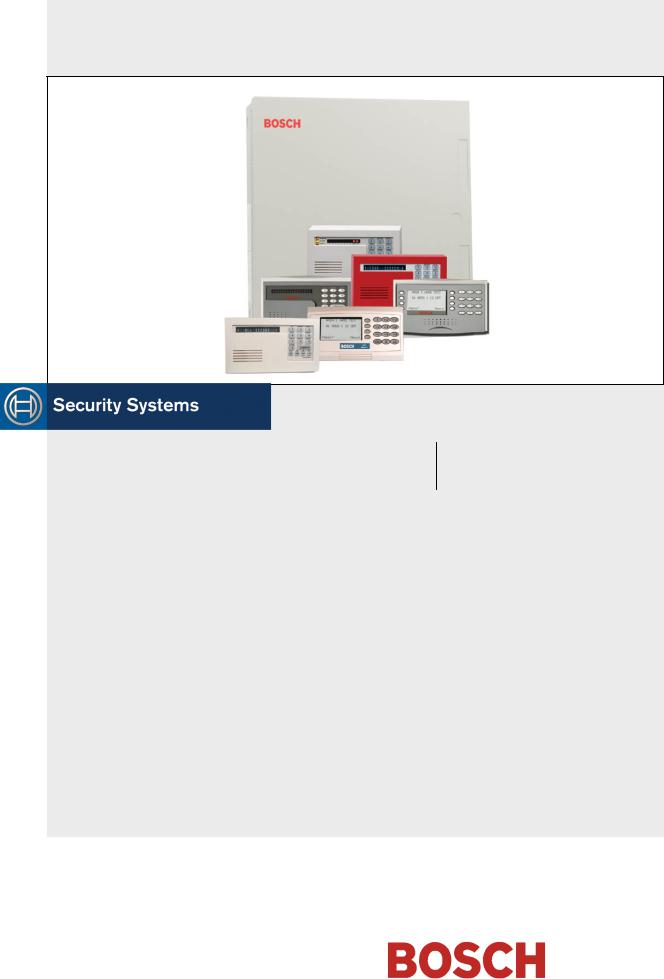
D9412GV2/D7412GV2
Operation and Installation Guide
EN Control Panels

D9412GV2/D7412GV2 | Operation and Installation Guide | Trademarks
Trademarks
CoBox is a registered trademark of Lantronix®.
Windows® is a registered trademark of Microsoft Corporation in the United States or in other countries.
Molex® is a registered trademark of Molex Incorporated.
Certifications and Approvals
The D9412GV2/D7412GV2 Literature Pack includes the D9412GV2/D7412GV2 Approved Applications Compliance Guide (P/N: F01U003639). Refer to this guide for additional guidelines on installing the control panels in Underwriters Laboratories Inc. (UL) and firespecific applications.
Listings and Approvals
Fire
UL
Underwriters Laboratories Inc. (UL) lists the D9412GV2/D7412GV2 Control Panels as Signal System Control Units for: Central Station, Local, Auxiliary, Remote Station, Proprietary, and Household Fire Warning.
Burglary
UL
UL lists the D9412GV2/D7412GV2 Control Panels for: Central Station, Local, Police Connect, Bank Safe and Vault, Mercantile Safe and Vault, and Grade A Household Systems.
Department of Defense (DOD)
The D9412GV2/D7412GV2 was granted approval for Department of Defense (DoD) installations in Sensitive Compartmented Information Facilities (SCIF).
Federal Communications
Commission (FCC) Rules
Part 15
This equipment was tested and found to comply with the limits for a Class A digital device, pursuant to Part 15 of the FCC rules. These limits are designed to provide reasonable protection against harmful interference when the equipment is operated in a commercial environment.
This equipment generates, uses, and can radiate radio frequency energy; and if not installed and used according to the instructions, can cause harmful interference to radio communications.
Operation of this equipment in a residential area is likely to cause harmful interference, in which case the user is required to correct the interference at his or her own expense.
Part 68
This equipment complies with Part 68 of FCC rules. A label contains, among other information, the FCC registration number and ringer equivalence number (REN). If requested, this information must be provided to the telephone company.
The D9412GV2 and D7412GV2 Control Panels are registered for connection to the public telephone network using an RJ38X or RJ31X jack.
The REN is used to determine the number of devices that can be connected to the telephone line. Excessive RENs on the telephone line may result in the devices not ringing in response to an incoming call. In most, but not all areas, the sum of the RENs should not exceed five. To be certain of the number of devices that may be connected to the line, as determined by the RENs, contact the telephone company to determine the maximum REN for the calling area.
If you experience trouble with the D9412GV2 or D7412GV2 Control Panel, please contact Bosch Security Systems Customer Service for repair and warranty information. If the trouble is causing harm to the telephone network, the telephone company may request that the equipment be removed from the network until the problem is resolved. User repairs must not be made, and doing so will void the user’s warranty.
2 |
Bosch Security Systems, Inc. | 5/05 | F01U003641B |

D9412GV2/D7412GV2 | Operation and Installation Guide | Federal Communications Commission (FCC) Rules
If the D9412GV2 or D7412GV2 Control Panel causes harm to the telephone network, the telephone company attempts to notify you in advance. If advance notice is not practical, the telephone company notifies you as soon as possible. Also, you will be advised of your right to file a complaint with the FCC if you believe it is necessary.
The telephone company may make changes in its facilities, equipment, operations, or procedures that could affect the operation of the equipment. If this happens, the telephone company provides advance notice in order for the necessary modifications to be made in order to maintain uninterrupted service.
This equipment cannot be used on public coin service provided by the telephone company. Connection to Party Line service is subject to state tariffs. (Contact your state public utilities commission for information.)
FCC Registration Number: AJ9MUL-46532-AL-E
Service Center in USA: National Repair Center
130 Perinton Parkway
Fairport, NY 14450
(800) 289-0096
Ringer Equivalence: 0.4B
Bosch Security Systems, Inc. | 5/05 | F01U003641B |
3 |

D9412GV2/D7412GV2 | Operation and Installation Guide | Contents
Contents |
|
|
1.0 |
Introduction....................................................... |
7 |
2.0 |
Lightning Strikes .............................................. |
8 |
2.1 |
Effects................................................................... |
8 |
2.2 |
Precautions during Installation.......................... |
8 |
3.0 |
Overview ........................................................... |
9 |
3.1 |
Configuration and Parts ..................................... |
9 |
3.1.1 |
Parts List ............................................................ |
10 |
3.1.2 |
Parts Available by Separate Order ................. |
10 |
3.2 |
Accessories ........................................................ |
11 |
3.3Features in the D9412GV2 and
|
D7412GV2 ........................................................ |
12 |
3.3.1 |
SDI Molex Connector ..................................... |
12 |
3.3.2 |
Tip and Ring Posts ........................................... |
12 |
3.3.3 |
Super Capacitor ................................................ |
12 |
3.3.4 |
Telephone Line Sniff........................................ |
12 |
3.3.5 |
Points.................................................................. |
12 |
3.3.6 |
Areas and Accounts.......................................... |
12 |
3.3.7 |
Digital Communicator ..................................... |
12 |
3.3.8 |
Keypads ............................................................. |
13 |
3.3.9 |
Keyswitch .......................................................... |
13 |
3.3.10 |
Access Control .................................................. |
13 |
3.3.11 |
Event Memory .................................................. |
13 |
3.3.12 |
Event Log .......................................................... |
13 |
3.3.13 |
Ground Fault Detection ................................... |
13 |
3.3.14 |
Ground Fault Detection Added Feature ........ |
13 |
3.3.15 |
NetCom Functions ........................................... |
14 |
3.3.16 |
Programming .................................................... |
14 |
3.3.17 |
Other Features .................................................. |
14 |
4.0 |
Installation ....................................................... |
15 |
4.1 |
Installation Preparation.................................... |
15 |
4.2 |
Enclosure Options ............................................ |
15 |
4.3 |
Mounting Enclosure ......................................... |
15 |
4.4 |
Installing the Control Panel............................. |
16 |
4.5 |
Connecting Earth Ground ............................... |
16 |
4.5.1 |
Terminal 10 ....................................................... |
16 |
4.5.2 |
Ground Fault Detect Enable ........................... |
16 |
4.5.3 |
Enabling Ground Fault Detection .................. |
17 |
4.5.4D9412GV2 and D7412GV2 Ground Fault
|
Specifications..................................................... |
17 |
4.5.5 |
Locking the Reset Pin ...................................... |
17 |
4.6 |
Completing the Installation ............................. |
18 |
4.6.1 |
Charging the Battery ........................................ |
18 |
4.6.2 |
Installing and Wiring Detection Devices ....... |
18 |
4.6.3 |
Installing Modules and Relays ........................ |
18 |
4.6.4Connecting the On-board Points
and Keypads...................................................... |
18 |
4.6.5 |
Poweringing Up................................................ |
18 |
4.7 |
Programming the Control Panel .................... |
19 |
4.8 |
Installing the Point Chart Label ..................... |
19 |
4.9 |
Testing the System ........................................... |
19 |
5.0 |
Power Supply.................................................. |
20 |
5.1 |
Primary Power Terminals 1 and 2 ................. |
20 |
5.1.1 |
Primary (AC) Power Circuit ........................... |
20 |
5.1.2 |
Installing the Transformer............................... |
20 |
5.2 |
Secondary Power Terminals ........................... |
20 |
5.2.1 |
Secondary (DC) Power .................................... |
20 |
5.2.2 |
Installing the Battery ........................................ |
21 |
5.2.3 |
Replacing the Battery ...................................... |
22 |
5.2.4 |
Battery Supervision .......................................... |
23 |
5.2.5 |
Battery Charging Circuit ................................. |
23 |
5.2.6 |
Battery Discharge and Recharge Schedule ... |
23 |
6.0 |
Power Outputs ................................................ |
25 |
6.1 |
Circuit Protection ............................................. |
25 |
6.2 |
Total Available Power ..................................... |
25 |
6.3Continuous Power Output
Terminals 3, 8, 24, and 32............................... |
25 |
6.4Programmable Power Output
|
Terminals 6, 7, and 8 ....................................... |
25 |
6.4.1 |
Programming .................................................... |
25 |
6.4.2 |
Terminals 6 and 7 ............................................ |
26 |
6.4.3 |
Fire System Power Formula ............................ |
26 |
6.4.4 |
Terminal 8......................................................... |
26 |
7.0 |
Telephone Connections ............................... |
27 |
7.1 |
Registration ....................................................... |
27 |
7.2 |
Notification ....................................................... |
27 |
7.3 |
Location............................................................. |
27 |
7.4 |
Telephone Cord Connection .......................... |
27 |
7.5 |
Phone LED (Red)............................................. |
28 |
7.6 |
Operation Monitor LED (Green) ................... |
28 |
7.7 |
Dialing Format.................................................. |
28 |
7.8 |
Telephone Line Monitor ................................. |
28 |
7.9 |
Called Party Disconnect .................................. |
28 |
7.10 |
Communication Failure................................... |
28 |
7.11 |
D928 Dual Phone Line Switcher.................... |
29 |
7.11.1 |
Description ........................................................ |
29 |
7.11.2 |
Operation .......................................................... |
29 |
7.11.3 |
Installing the D928........................................... |
30 |
7.11.4 |
D928 Status LEDs ............................................ |
30 |
8.0 |
On-Board Points ............................................. |
31 |
8.1 |
Terminals 11 to 22 Description ...................... |
31 |
8.2 |
Point Sensor Loops .......................................... |
31 |
8.3 |
Point Parameters............................................... |
31 |
8.4 |
Point Response Time ....................................... |
32 |
4 |
Bosch Security Systems, Inc. | 5/05 | F01U003641B |

D9412GV2/D7412GV2 | Operation and Installation Guide |
8.5Wiring Information for Installations
|
Using the Ademco AB-12 Bell/Housing........ |
32 |
9.0 |
Off-Board Points ............................................. |
34 |
9.1Point (Zonex) Bus: D9412GV2 Terminals
|
and D7412GV2 Terminals .............................. |
34 |
9.1.1 |
POPIT Modules................................................ |
34 |
9.1.2 |
POPEX Modules .............................................. |
34 |
9.1.3 |
Missing Conditions........................................... |
34 |
9.1.4 |
Extra Point Events ............................................ |
34 |
9.1.5D7212GV2 Responses to
Missing Point Conditons.................................. |
35 |
9.2D8125, D8127 and D9127 POPIT Modules . 35
9.3 |
Installing the D8125 POPEX Module ........... |
38 |
9.3.1 |
Mounting ........................................................... |
38 |
9.3.2 |
Wiring the D8125 to the Control Panel......... |
38 |
9.3.3Wiring POPITs to the
Data Expansion Loop ...................................... |
38 |
9.3.4Wiring Data Expansion Loops to
|
POPEX Modules .............................................. |
39 |
9.3.5 |
POPIT Sensor Loops ....................................... |
39 |
9.3.6 |
POPIT Module Point Assignments ................ |
39 |
9.3.7 |
Program Record Sheet ..................................... |
39 |
9.3.8 |
POPIT Labels ................................................... |
40 |
9.4 |
D8128D OctoPOPIT Module......................... |
40 |
9.4.1 |
Description ........................................................ |
40 |
9.4.2 |
Listings ............................................................... |
40 |
9.4.3 |
Installation ......................................................... |
41 |
9.4.4 |
Setting the OctoPOPIT Switches.................... |
41 |
9.4.5 |
Mounting OctoPOPITs.................................... |
42 |
9.4.6 |
Wiring OctoPOPITs......................................... |
42 |
9.4.7 |
OctoPOPIT Sensor Loops............................... |
46 |
9.5 |
Testing Off-Board Points ................................. |
47 |
10.0 |
Off-Board Relays ............................................ |
48 |
10.1 |
D8129 OctoRelay ............................................. |
48 |
10.1.1 |
Configuring the D8129 OctoRelay ................ |
49 |
10.1.2 |
Relay Outputs ................................................... |
49 |
10.1.3 |
Installation ......................................................... |
49 |
10.1.4 |
Wiring Connections ......................................... |
50 |
10.2 |
D811 Arm Status Relay Module..................... |
50 |
10.2.1 |
Relay Output..................................................... |
50 |
10.2.2 |
Installation ......................................................... |
51 |
10.2.3 |
Wiring Connections ......................................... |
51 |
11.0 |
Arming Devices .............................................. |
53 |
11.1 |
Description ........................................................ |
53 |
11.2 |
Keypad Terminals 29 to 32 ............................. |
53 |
11.2.1 |
Assigning an Address for the Keypad............ |
53 |
11.2.2 Installation......................................................... |
53 |
11.3D268/D269 Independent Zone Control,
|
D279A Independent Zone Control................ |
55 |
11.4 |
Keyswitch .......................................................... |
55 |
11.4.1 |
Description ........................................................ |
55 |
11.4.2 |
Programming .................................................... |
55 |
11.4.3 |
Installation......................................................... |
55 |
12.0 |
SDI Devices ..................................................... |
57 |
12.1 |
Description ........................................................ |
57 |
12.2 |
Installation......................................................... |
57 |
12.3D9131A Parallel Printer
|
Interface Module .............................................. |
57 |
12.3.1 |
Switch Settings .................................................. |
57 |
12.3.2 |
Supervision........................................................ |
57 |
12.4D9210B Wiegand Control
|
Interface Module .............................................. |
57 |
12.4.1 |
Access ................................................................ |
58 |
12.4.2 |
Switch Settings .................................................. |
58 |
12.5 |
SDI Address 80................................................. |
58 |
12.5.1 |
Serial Interface Modules (SIMs) ..................... |
58 |
12.5.2 |
Address Settings ............................................... |
58 |
12.5.3 |
Supervision........................................................ |
59 |
12.6 |
SDI Address 88................................................. |
59 |
12.6.1D9133DC Direct Connect Programming
|
Module .............................................................. |
59 |
12.6.2 |
Network Interface Modules ............................ |
59 |
12.6.3 |
Address Settings ............................................... |
60 |
12.6.4 |
Supervision........................................................ |
60 |
13.0Programmer and Accessory
|
Connections..................................................... |
61 |
13.1 |
Programmer Connector................................... |
61 |
13.2 |
Programmer Access Reports........................... |
61 |
13.3 |
Accessory Connector ....................................... |
61 |
14.0 |
Faceplates ........................................................ |
62 |
14.1 |
D9412GV2 Faceplate ...................................... |
62 |
14.2 |
D7412GV2 Faceplate ...................................... |
63 |
Appendix A: System Wiring Diagrams, |
|
|
|
Issue A .............................................................. |
64 |
A.1 |
D9412GV2 Control Panel............................... |
64 |
A.2 |
D7412GV2 Control Panel............................... |
67 |
Appendix B: Point Address Charts .......................... |
70 |
|
B.1 |
Zonex 1, Points 9 to 127 (D9412GV2); |
|
|
Zonex 1, Points 9 to 75 (D7412GV2) ............ |
70 |
B.2 |
Zonex 2, Points 129 to 247 |
|
|
(D9412GV2 Only) ........................................... |
71 |
Specifications................................................................. |
72 |
|
Bosch Security Systems, Inc. | 5/05 | F01U003641B |
5 |

D9412GV2/D7412GV2 | Operation and Installation Guide | 1.0 Introduction
Figures |
|
|
Figure 1: |
System Configuration ................................. |
9 |
Figure 2: |
Enclosure Mounting.................................. |
15 |
Figure 3: |
Ground Fault Detection............................ |
16 |
Figure 4: |
Reset Pin..................................................... |
17 |
Figure 5: |
Non-Power-Limited Wiring ..................... |
22 |
Figure 6: |
Charging and Battery LEDs..................... |
23 |
Figure 7: |
RJ31X Wiring ............................................ |
27 |
Figure 8: |
Phone Connector, Phone LED, and |
|
|
Operation Monitor LED Locations......... |
27 |
Figure 9: |
D928 Dual Phone Line Switcher............. |
29 |
Figure 10: |
On-board Point Sensor Loop Wiring...... |
31 |
Figure 11: |
Wiring for Installation Using the |
|
|
Ademco AB-12 Bell/Housing .................. |
33 |
Figure 12: |
Connecting the D8125 POPEX to the |
|
|
D9412GV2 Control Panel........................ |
36 |
Figure 13: |
Connecting the D8125 POPEX to the |
|
|
D7412GV2 Panel ...................................... |
37 |
Figure 14: |
Program Record Sheet.............................. |
40 |
Figure 15: |
D8128D OctoPOPIT Layout ................... |
41 |
Figure 16: |
Connecting D8128D OctoPOPITs |
|
|
to the D9412GV2 ...................................... |
44 |
Figure 17: |
Connecting D8128D OctoPOPITs |
|
|
to the D7412GV2 ...................................... |
45 |
Figure 18: |
Wiring Multiple D8128Ds Using |
|
|
Molex® Connectors ................................... |
46 |
Figure 19: |
D8128D OctoPOPIT Sensor Loops........ |
47 |
Figure 20: |
D8129 Connections to the |
|
|
D9412GV2 ................................................. |
48 |
Figure 21: |
D8129 Connections to the |
|
|
D7412GV2 ................................................. |
49 |
Figure 22: |
D811 Module Wiring to the |
|
|
D9412GV2 ................................................. |
51 |
Figure 23: |
D811 Module Wiring to the |
|
|
D7412GV2 ................................................. |
52 |
Figure 24: |
Power at Keypads...................................... |
54 |
Figure 25: |
Keyswitch Wiring ...................................... |
55 |
Figure 26: |
D9133 Jumper Setting for Address 80 .... |
58 |
Figure 27: |
DX4020i DIP Switch Settings .................. |
59 |
Figure 28: |
DX4020 DIP Switch Settings ................... |
60 |
Figure 29: |
D9133TTL-E Jumper Setting for |
|
|
Address 88.................................................. |
60 |
Figure 30: |
Reset Pin..................................................... |
61 |
Figure 31: |
Programmer and Accessory |
|
|
Connections ............................................... |
61 |
Figure 32: |
D9412GV2 Faceplate ............................... |
62 |
Figure 33: |
D7412GV2 ................................................. |
63 |
Figure 34: |
D9412GV2, Power Supply Side .............. |
64 |
Figure 35: |
D9412GV2, Input Points and |
|
|
Peripheral Devices .................................... |
65 |
Figure 36: |
D9412GV2, SDI Devices ......................... |
66 |
Figure 37: |
D7412GV2, Power Supply Side.............. |
67 |
Figure 38: |
D7412GV2, Input Points and |
|
|
Peripheral Devices .................................... |
68 |
Figure 39: |
D7412GV2, SDI Devices ......................... |
69 |
Tables |
|
|
Table 1: |
Related Documentation.............................. |
7 |
Table 2: |
9000GV2 Series Control Panel |
|
|
Differences ................................................... |
9 |
Table 3: |
Compatible Accessories ........................... |
11 |
Table 4: |
Compatible Keypads ................................ |
13 |
Table 5: |
Ground Fault Detection Status ................ |
17 |
Table 6: |
Ground Fault Impedance Specifications 17 |
|
Table 7: |
Battery Discharge and Recharge |
|
|
Schedule ..................................................... |
23 |
Table 8: |
Charging Status and Low Battery LEDs 24 |
|
Table 9: |
Phone Cord Lengths................................. |
30 |
Table 10: |
Point Parameters ....................................... |
31 |
Table 11: |
POPEX Modules....................................... |
34 |
Table 12: |
Extra Point Events .................................... |
34 |
Table 13: |
Off-Board Point Errors ............................. |
35 |
Table 14: |
Data Expansion Loop Wire |
|
|
Specifications ............................................. |
38 |
Table 15: |
D8128D OctoPOPIT Switch Settings |
|
|
for D9412GV2 and D7412GV2.............. |
42 |
Table 16: |
Switch 5 Settings for Line Termination .. |
42 |
Table 17: |
Terminal Strip Connections..................... |
43 |
Table 18: |
D8129 OctoRelay Switch Settings .......... |
49 |
Table 19: |
Number of D8128Ds Used with |
|
|
D8129s........................................................ |
50 |
Table 20: |
Keypad Address Settings.......................... |
53 |
Table 21: |
Keypad Connections ................................ |
53 |
Table 22: |
SDI Device Connections.......................... |
57 |
Table 23: |
Printer Address Switch Settings............... |
57 |
Table 24: |
Address Switch Settings for Access |
|
|
Control Module......................................... |
58 |
Table 25: |
Zonex 1 Point Address Chart .................. |
70 |
Table 26: |
Zonex 2 Point Address Chart .................. |
71 |
Table 27: |
Specifications ............................................. |
72 |
6 |
Bosch Security Systems, Inc. | 5/05 | F01U003641B |

D9412GV2/D7412GV2 | Operation and Installation Guide | Tables
1.0 Introduction
This manual addresses the operation and installation of the D9412GV2 and D7412GV2 Control Panels. Throughout this guide, the words “control panel” refer to both control panels (D9412GV2 and D7412GV2).
Table 2 on page 9 provides an overview of the differences between the D9412GV2 and D7412GV2 control panels.
Table 1: |
Related Documentation |
|
|
|
|
|
|
|
Name of Documentation |
Part Number |
|
D1255 Installation Instructions |
74-06819-000 |
|
D1256/D1257 Installation Instructions |
74-06925-000 |
|
D1260 Installation Guide |
48101 |
|
D1260 Owner’s Manual |
50410 |
|
D5200 Operation Manual |
74-06176-000 |
|
D720 Installation Instructions |
74-06918-000 |
|
D7412GV2 Release Notes |
43856 |
|
D8125MUX Operation & Installation Guide |
36796 |
|
D9210B Operation and Installation Guide |
32206 |
|
D9412GV2 Release Notes |
F01U003637 |
|
D9412V2G/D7412V2G Approved Applications Compliance Guide |
F01U003639 |
|
D9412GV2/D7412GV2 Installation and Troubleshooting Quick Reference Guide |
F01U003638 |
|
D9412GV2/D7412GV2 New Features |
43746 |
|
D9412GV2/D7412GV2 Operation and Installation Guide (this document) |
F01U003641 |
|
D9412G/D7412G Program Entry Guide |
F01U003636 |
|
D9412GV2/D7412V2G Program Record Sheet |
F01U003635 |
|
RPS Operations Manual |
38849 |
|
Security System Owner's Manual |
71-06633-000 |
|
Security System Owner's Manual Supplement |
33267 |
|
UL Certificated Bank Safe and Vault Applications Technogram |
73-07302-000 |
|
9000/G/GV2 Series Technical Service Note: UL Smoke Detector Compatibility |
33284 |
|
D8128D Installation Guide |
41323 |
|
D268/D269 Operation and Installation Instructions |
74-004758-000 |
|
D279A Operation and Installation Instructions |
46458 |
|
|
|
|
|
To obtain any of these documents, please contact Bosch Security Systems Technical Support and request the documentation by its |
|
|
|
corresponding part number. |
Bosch Security Systems, Inc. | 5/05 | F01U003641B |
7 |

D9412GV2/D7412GV2 | Operation and Installation Guide | 2.0 Lightning Strikes
2.0 Lightning Strikes
The control panels are designed to significantly reduce electromagnetic interference and malfunction generally caused by lightning.
2.1Effects
Any electronic system can be struck directly by lightning or be adversely affected by a lightning strike near the system. When lightning strikes, several things happen:
•An electromagnetic wave spreads from the point of the strike inducing high voltages in nearby conductors.
•The voltage changes substantially on electrical grounds near the lightning strike.
•High voltages are induced upon anything directly struck by lightning.
Symptoms of installations that lightning might strike or affect are Missing Trouble, Missing Alarm, or Point Bus Trouble events. Occasionally, Reboot and Watchdog events might be sent because the control panel tried to reset itself.
Electronic systems, including control panels, cannot be completely immune to direct or indirect lightning strikes; however, some proven installation practices might greatly reduce the risk of undesirable affects.
2.2Precautions during Installation
To minimize the risk of undesirable effects from lightning strikes on high risk installations that use a point-bus technology:
•Do not run wiring outside the building.
•If you must install the unit in a metal building, keep the wiring at least 0.61 m (2 ft) away from external metal surfaces.
•Earth ground the unit correctly. Do not use an electrical ground or telephone ground.
•Avoid running wires near telephone, data, or power lines inside a building. Historical evidence shows that locating control panel wiring at least 0.61 m (2 ft) away from telephone, data, or power lines is successful at minimizing lightning damage. When your data lines must cross the path of AC or other wiring, cross the lines perpendicularly.
8 |
Bosch Security Systems, Inc. | 5/05 | F01U003641B |
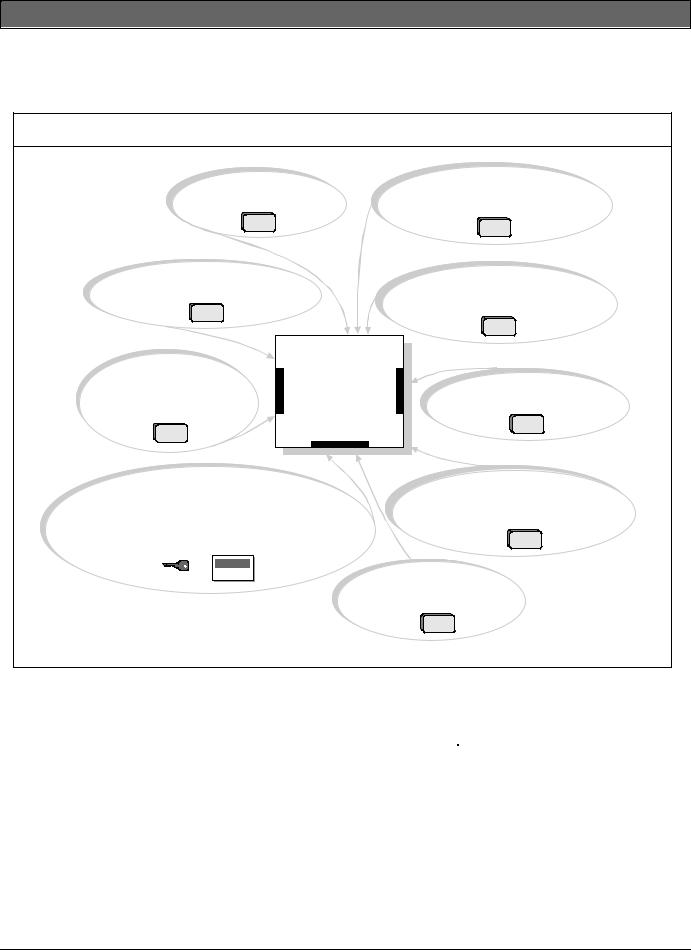
D9412GV2/D7412GV2 | Operation and Installation Guide | 3.0 Overview
3.0Overview
3.1Configuration and Parts
Figure 1: System Configuration
D9210B Modules can be used for access control.
Each D8128D OctoPOPIT combines eight POPIT points in one module.
D8129 OctoRelay provides alarm and auxiliary relay output.
(Other functions available.)
DX4020 allows communciation over a Local or Wide Area Network (LAN/WAN).
D8125, D8125INV, or D8125MUX Interface used for point expansion.
Control |
Panel |
On-Board Points |
1 to 8 |
D928 Module allows the control panel to monitor two phone lines.
Use keypads or keyswitches to arm the control
panel by area. Each control panel can have up to eight areas. Each area can have its own account number or areas can be grouped together with a common account number. Points of protection are assigned to areas.
D8132 Modules (two 12 VDC, 7Ah batteries) provide additional power for keypads and other powered devices.
D9131A Module connects to a parallel printer to print the event log.
|
Table 2: |
GV2 Series Control Panel Differences |
|
|
||||
|
|
|
|
|
|
|
|
|
|
|
|
|
|
|
|
|
|
|
Features |
|
D9412GV2 |
D7412GV2 |
D7212GV2 |
|||
|
|
|
|
|
|
|
|
|
|
Access Control |
Yes - 8 doors |
|
Yes - 2 doors |
|
No |
|
|
|
Arm/Disarm Passcodes |
249 |
|
99 |
|
99 |
|
|
|
Cards/Tokens |
|
996 |
|
396 |
|
N/A |
|
|
Passcode-Protected |
16 |
|
4 |
|
4 |
|
|
|
Custom Functions |
|
|
|
||||
|
|
|
|
|
|
|
||
|
Number of Printers |
3 |
|
1 |
|
1 |
|
|
|
Number of Points |
246 |
|
75 |
|
40 |
|
|
|
|
|
|
|
|
|
|
|
|
Number of Relays |
128 |
|
64 |
|
24 |
|
|
|
Number of Areas |
8 |
|
8 |
|
4 |
|
|
|
|
|
|
|
|
|
|
|
Bosch Security Systems, Inc. | 5/05 | F01U003641B |
9 |

D9412GV2/D7412GV2 | Operation and Installation Guide | 3.0 Overview
3.1.1Parts List
The D9412GV2 andD7412GV2 Control Panels are shipped assembled from the factory with the following parts:
Literature Pack
•D9412GV2/D7412GV2/D7212GV2 Installation and Troubleshooting Quick Reference Guide
(P/N: F01U003638)
•D9412GV2/D7412GV2 Program Record Sheet
(P/N: F01U003635)
•9000/G/GV2 Series Technical Service Note: UL Smoke Detector Compatibility (P/N: 33284)
•7000/9000 Series Point Chart Label
(P/N: 79-06660-000)
Assembly
•PC board
•Faceplate shield
•Mounting skirt
•One #6 x 1/4-in. screw
3.1.2Parts Available by Separate Order
Order the following components separately to complete a basic eight-point installation.
•D1255, D1256, D1257, D1260, or D720 Command Center (or keypad)
•D1640 Transformer
•D126 or D1218 Battery
•D161 or D162 Phone Cord (order two cords if using the D928 Dual Phone Switcher)
•D8103, D8108A, or D8109 Enclosure
Configured packages are also available. Please consult the Bosch Security Systems product catalog.
The following literature is available in a separate literature package for dealers.
•D9412GV2/D7412GV2 Operation and Installation Guide (P/N: F01U003641)
•D9412GV2/D7412GV2 Approved Applications Compliance Guide (P/N: F01U003639)
•D9412GV2/D7412GV2 Program Entry Guide
(P/N: F01U003636)
•D9412GV2/D7412GV2 Program Record Sheet
(P/N: F01U003635)
10 |
Bosch Security Systems, Inc. | 5/05 | F01U003641B |

D9412GV2/D7412GV2 | Operation and Installation Guide | 3.0 Overview
3.2Accessories
Refer to the Bosch Security Systems product catalog for additional information.
Table 3: |
Compatible Accessories |
|
|
|
|
|
|
|
|
|
|
|
|
|
Model |
|
Title |
Model |
Title |
|
|
|
|
|
D122/D122L |
|
Dual Battery Harness |
D1260 |
Alpha V Command Center |
D125B |
|
Powered Loop Interface Module |
D1640 |
16.5 VAC 40 VA Transformer |
D127 |
|
Reversing Relay |
D5200 |
Programmer |
D129 |
|
Dual Class A Initiation Circuit |
D5500 |
Remote Programming Software (RPS) |
|
|
Module |
|
|
|
|
|
|
|
D130 |
|
Relay Module |
D8004 |
Transformer Enclosure |
D136 |
|
Plug-In Relay |
D8121A, D8122 |
Derived Channel STU |
|
|
|
|
|
D161 |
|
Phone Cord [2.4 m (8 ft)] |
D8125 |
POPEX Module |
D162 |
|
Phone Cord [0.6 m (2 ft)] |
D8125MUX |
Multiplex Bus Interface |
|
|
|
|
|
D185 |
|
Reverse Polarity Module |
D8125INV* |
Wireless Interface Module |
D192C/D192G |
Bell Circuit Supervision Module |
D8128D |
OctoPOPIT Module |
|
|
|
|
|
|
D279A |
|
Independent Zone Control |
D8129 |
OctoRelay Module |
|
|
(On-Board and OctoPOPIT Points) |
|
|
D442 |
|
Bells [4 cm (10 in.)] |
D8130 |
Release Module |
|
|
|
|
|
D448/D449 |
|
Mini-horns |
D8132 |
Battery Charger Module |
D720 |
|
Command Center (Area LED) |
D9002-5 |
Accessory Module Mounting Skirt |
|
|
|
|
|
D720R |
|
LED Command Center (red) |
D9127U/T |
POPIT Module |
D720W |
|
LED Command Center (white) |
D9131A |
Parallel Printer Interface Module |
|
|
|
|
|
D928 |
|
Dual Phone Line Switcher |
D9210B |
Access Control Interface Module |
D1218 |
|
12 V, 17.2 Ah Rechargeable |
ZX776Z |
PIR Motion Sensor [15 m (50 ft)] with |
|
|
Battery |
|
POPIT |
D1255 |
|
Command Center (General |
ZX794Z |
PIR Motion Sensor [24 m (80 ft)] with |
|
|
Purpose) |
|
POPIT |
D1255R |
|
Text Command Center (red) |
ZX865 |
PIR/Microwave Motion Sensor |
|
|
|
|
[+1.7°C (+35°F)] with POPIT |
D1255W |
|
Text Command Center (white) |
ZX938Z |
PIR Motion Sensor [18 m (60 ft)] with |
|
|
|
|
POPIT |
D1256 |
|
Fire Command Center |
ZX970 |
PIR/Microwave Motion Sensor |
|
|
|
|
[+1.7°C (+35°F)] with POPIT |
D1257 |
|
Fire Annunciator |
|
|
* The D8125INV was not investigated by UL. Do not use D8125INV in UL Listed installations.
Bosch Security Systems, Inc. | 5/05 | F01U003641B |
11 |
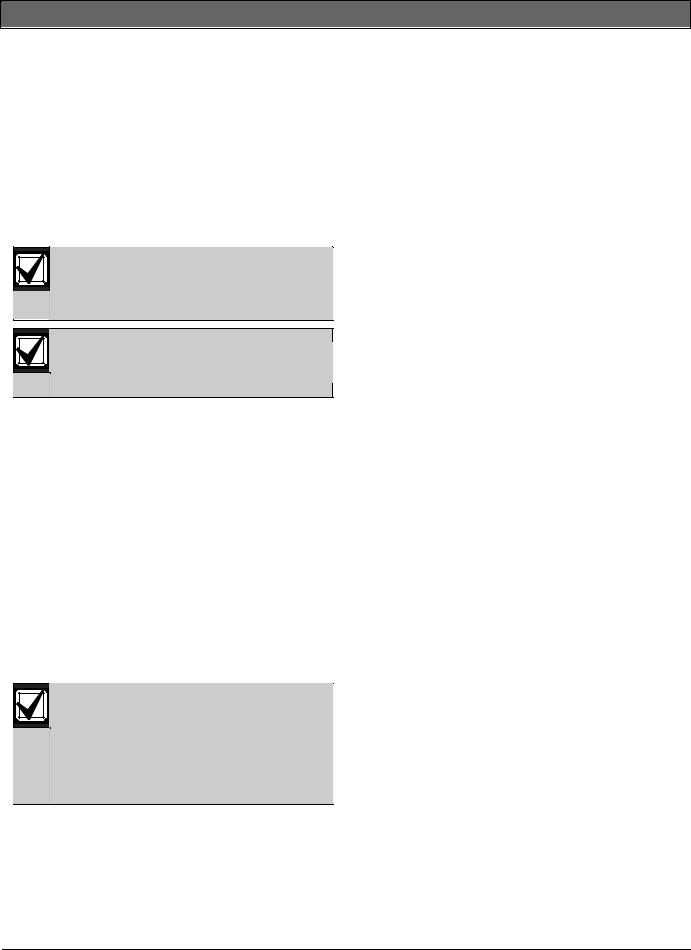
D9412GV2/D7412GV2 | Operation and Installation Guide | 3.0 Overview
3.3Features in the D9412GV2 and D7412GV2
3.3.1SDI Molex Connector
Use the SDI Molex Connector to connect easily an SDI device with the SDI bus, without needing to disconnect wires connected to the SDI terminals. Possible applications include:
•Connecting a DX4010i to program the control panel with Remote Programming Software (RPS) at the premises
•Connecting a keypad to test the control panel.
3.3.2Tip and Ring Posts
The tip and ring posts allow connecting a phone or buttset for the purpose of troubleshooting communications between the control panel and the central station. With this connection, the dial tone, ACK tone handshake, and ACK and NACK signals can be monitored.
3.3.3Super Capacitor
The D9412GV2 and D7412GV2 have a capacitor called Super Cap. This component preserves the parameters stored in the control panel’s RAM chip when the lithium battery is replaced. The Super Cap can retain voltage for up to 30 minutes after the lithium battery is removed.
Plan to replace the lithium battery after 3 to 5 years of continual service.
|
When replacing the lithium battery, ensure |
|
that you disconnect the primary AC power |
|
and secondary battery power from the |
|
control panel before you remove the old |
|
battery. Then install the new battery and |
|
connect the primary AC and secondary |
|
battery power to the control panel. |
3.3.4 |
Telephone Line Sniff |
The D9412GV2 and D7412GV2 control panels monitor the phone line for the programmed supervision interval before indicating a phone line trouble. Phone line trouble occurs when the phone line voltage drops to 6 V or below, without a corresponding 8 mA to 13 mA increase in current.
3.3.5Points
The Bosch Security Systems D9412GV2 Control Panel provides up to 246 points of protection. The D7412GV2 Control Panel provides up to 75 points of protection. Point programming parameters determine the control panel response to open and shorted conditions on the sensor loop for the point. Several options allow individual point programming to customfit the protection to the installation.
Points 1 to 8 are located on the circuit board (on-board points). They are standard sensor loops. The remaining off-board points are POPIT points using D8128D OctoPOPITs, D8125 POPEX Modules and D9127 or D8127 POPITs. MUX devices can also be used with D8125MUX or wireless transmitters with the D8125INV.
3.3.6Areas and Accounts
The system supports up to eight separate areas. You can assign all points to a single area or distribute them over as many as eight areas.
The control panel is armed and disarmed by area, and several areas can be armed and disarmed with one menu function. A passcode can also be assigned an authority level that allows a user to arm an area from a remote keypad in another area. Assigning each area its own account number creates eight separate accounts in one control panel. Assigning the same account number to different areas groups them together in a single account.
Area options include exit tone and delay, separate fire and burglary outputs, and multiple opening and closing windows. Area type can be used to create area interdependencies for arming purposes.
3.3.7Digital Communicator
The control panel uses a built-in digital communicator to send reports to the receiver. The control panel sends reports in either the Modem IIIa2 or BFSK format. The MPU and line cards for the D6500 or D6600 receiver must have software revision 8.00 (or greater) installed to accept Modem IIIa2 reports from the control panel. Refer to the D6500 or D6600 literature to determine the MPU software version.
The control panel connects to an RJ31X or RJ38X jack for telephone line seizure. Connecting to the RJ31X complies with FCC regulations for using the public telephone network. The control panel can be programmed to direct reports to four separate telephone numbers. Adding the D928 Dual Phone Line Switcher Module allows connecting and supervising a second telephone line.
12 |
Bosch Security Systems, Inc. | 5/05 | F01U003641B |
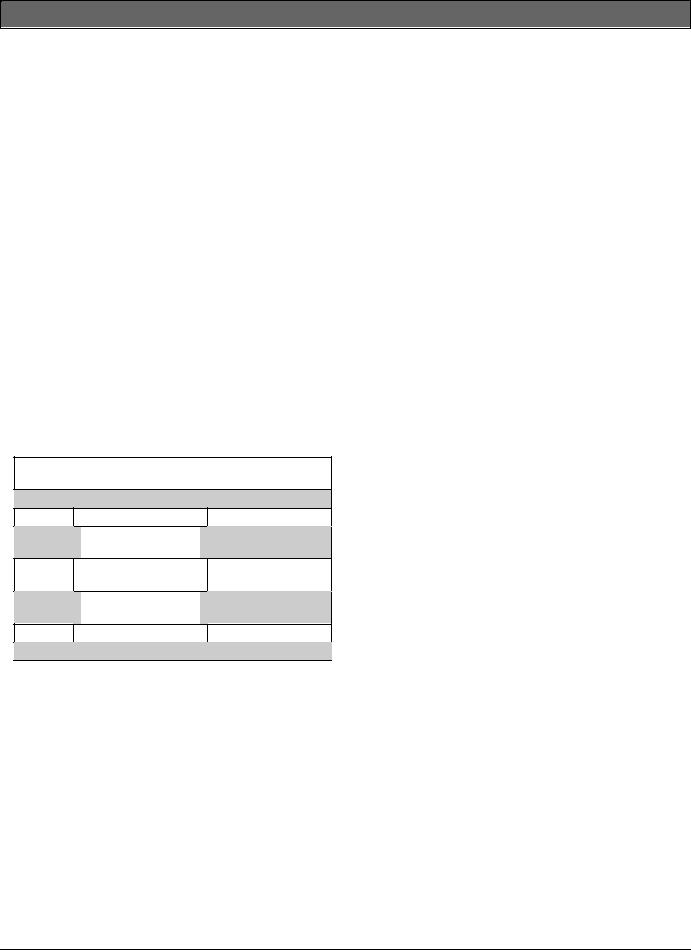
D9412GV2/D7412GV2 | Operation and Installation Guide | 3.0 Overview
The system can route groups of Event Reports to four different destinations. Each report group can be programmed to send reports to one or more destinations. Primary and backup reporting paths can be programmed for each destination and each report group. A custom option allows specification of individual Event Reports to be sent.
3.3.8Keypads
Up to 32 unsupervised keypads can be connected to the system. The available power, number of supervised keypads, and number of areas covered affect the total number of keypads that can be connected.
The system can supervise up to eight keypads. The control panel sends a Serial Device Trouble Report, SDI FAILURE in the Modem IIIa2 format or TROUBLE ZN D in the BFSK format, if it loses communication with a supervised keypad.
More than eight keypads can be added, but supervision of only eight is possible. Table 4 on page 13 shows the compatible keypads with the D9412GV2 and D7412GV2 Control Panels. Refer to Keypad in the
D9412GV2/D7412GV2 Program Entry Guide
(P/N: F01U003639) for complete details on programming keypad options.
Table 4: Compatible Keypads
Model |
Display |
Application |
D1255 |
16-character |
Fire/Burglary/Access |
|
alphanumeric |
|
D1256 |
16-character |
Fire |
|
alphanumeric |
|
D1257 |
16-character |
Fire |
|
alphanumeric |
|
D1260 |
4-line by 20-character |
Fire/Burglary |
D720 |
8 LED |
Fire/Burglary |
3.3.9Keyswitch
Maintained or momentary closure devices such as keyswitches allow any of the four available areas to be armed or disarmed. Point programming determines the loop responses and which area a keyswitch controls.
3.3.10 Access Control
The D9412GV2 can control eight access doors (each requiring the optional D9210B Wiegand Control Interface Module) with up to 996 uniquely identified cards or tokens. The D7412GV2 can control two access doors with up to 396 uniquely identified cards or tokens. Any of the following can grant access:
•Wiegand-style access control device (card reader) connected to the D9210B Access Control Interface Module
•Request to enter (RTE) or request to exit (REX) input
•Keypad
The access control features of the D9412GV2 and D7412GV2 can deny access during armed periods. The control panel can also grant access only to certain authorized users depending on whether the area is master armed, perimeter armed, or disarmed. Programming for automatic disarming when designated authorized users are granted access is also possible.
3.3.11 Event Memory
The system uses event memory to store events for each area. A D1255 Keypad or D1260 Keypad assigned to an area allows viewing of the events for the area. The control panel clears the events for an area from event memory and starts storing new events when the area is master armed.
3.3.12 Event Log
The system stores 500 to 1000 events and event modifiers from all areas in its event log. Event modifiers add information about an event to the log. Some events are always followed by a modifier. For example, the system adds at least two items to the log each time an area is armed or disarmed, the open (or close) event and an event modifier showing the previous arming state.
All events and their modifiers can be stored even if the control panel does not send a report for them. The log can be viewed at a keypad, printed locally using the D9131A Parallel Printer Interface Module and a parallel printer, or uploaded using Remote Programming Software (RPS).
For a list of the log events and event modifiers, refer to the appendix in the user’s guide for the keypad.
3.3.13 Ground Fault Detection
The Earth Ground Terminal on the control panels is electrically isolated from all other terminals to allow the D9412GV2 and the D7412GV2 to detect ground fault conditions. A Ground Fault Detect Enable switch (S4) is located just under Terminal 10, Earth Ground, on the control panel. Refer to Section 4.5.2 Ground Fault Detect Enable on page 16 for information on operating this function.
3.3.14 Ground Fault Detection Added Feature
When Ground Fault Detect is enabled (S4 closed), Points 1 to 8 can be used for non-powered fireinitiating devices such as heat detectors, four-wire smoke detectors, and pull stations. A D125B Powered Loop Interface or a D129 Dual Class A Interface Module is not required when connecting the nonpowered fire-initiating devices to Points 1 to 8.
Bosch Security Systems, Inc. | 5/05 | F01U003641B |
13 |

D9412GV2/D7412GV2 | Operation and Installation Guide | 3.0 Overview
3.3.15 NetCom Functions
The D6600 NetCom System supports data network communications. NetCom allows the D6600 receiver to connect to various network topologies, specifically Ethernet and token-ring. NetCom also allows this receiver to process messages to and from most networks using TCP/IP protocols. Connecting to a data network is possible using the COM4 or COM1 connection from the D6600 receiver to the D6680 Network Adapter. Alarm control panels can send reports through telephone lines or Ethernet and tokenring data networks to the D6600 receiver and then to the central station automation software or the network printer through a local area network (LAN) or wide area network (WAN). The network can monitor the status of alarm control panels.
3.3.16 Programming
Use the Bosch Security Systems D5200 Programmer or the Remote Programming Software (RPS) to program the D9412GV2 and D7412GV2 Control Panels. Refer to the D9412GV2/D7412GV2 Program Entry Guide
(P/N: F01U003636) for programming options.
3.3.17 Other Features
D9412GV2 and D7412GV2 Control Panels have many programmable features. Some of the features are listed below. Complete details on all features are in the
D9412GV2/D7412GV2 Program Entry Guide
(P/N: F01U003636).
•Supervision of AC (primary power), battery (secondary power), Zonex and SDI buses, central processing unit (CPU), up to three printers, and two telephone lines
•Automatic System Test Reports
•Remote access for programming, diagnostics, and log uploads using the remote programming software (RPS)
•Fire alarm verification
•Programmable alarm output
•Programmable relay output using the D8129 OctoRelay Module
•Opening and closing windows
•Skeds (scheduled events)
14 |
Bosch Security Systems, Inc. | 5/05 | F01U003641B |

D9412GV2/D7412GV2 | Operation and Installation Guide | 4.0 Installation
4.0Installation
4.1Installation Preparation
This section contains a general installation procedure and refers to other sections of the document for detailed instructions.
Review this document and the D9412GV2/D7412GV2 Program Entry Guide (P/N: F01U003636) before beginning the installation to determine the hardware and wiring requirements for the features used.
Have the following documentation available when reading through this guide:
•D9412GV2/D7412GV2 Program Record Sheet (P/N: F01U003635)
•Security System Owner’s Manual
(P/N: 71-06633-000) and Security System Owner’s Manual Supplement (P/N: 33267)
•Command center (keypad) installation manual (D1255, D1256, D1257, D1260, or D720)
Before installation, become familiar with the operation of the D5200 Programmer or the RPS.
4.2Enclosure Options
Mount the control panel assembly in any of the Bosch Security Systems enclosures listed:
•D8103 Universal Enclosure (tan)
•D8109 Fire Enclosure (red)
•D8108A Attack Resistant Enclosure (tan)
Refer to the D9412GV2/D7412GV2 Approved Applications Compliance Guide (P/N: F01U003639)to determine if the application requires a specific enclosure.
4.3Mounting Enclosure
1.Run the necessary wiring throughout the premises.
2.Mount the enclosure in the desired location. Use all five enclosure mounting holes. Refer to Figure 2.
3.Pull the wires into the enclosure.
Electro-Magnetic Interference (EMI) can cause problems on long wire runs. Refer to EMI on Long Wire Runs in the D9412GV2/D7412GV2/D7212GV2 Installation and Troubleshooting Quick Reference Guide
(P/N: F01U003638).
Figure 2: |
Enclosure Mounting |
|
|
|
|
|
1 |
2 |
3 |
2 |
4 |
|
|
||||
|
|
|
|
||
|
|
|
|
|
7 |
|
|
|
|
|
8 |
|
|
|
|
|
3 |
|
|
|
|
5 |
|
|
|
|
|
|
9 |
|
|
|
6 |
|
|
1 - |
Point chart label |
6- |
Enclosure mounting holes (5) |
2 - Mounting skirt hooks (2) |
7 - |
Mounting skirt hook holes (2) |
|
3 - Module mounting holes (12) |
8 - |
Back of D9412GV2/D7412GV2 Control Panel |
|
4 - Tamper switch mounting holes (5) |
9 - |
Lock down tab |
|
5 - |
Skirt mounting hole (1) |
|
|
Bosch Security Systems, Inc. | 5/05 | F01U003641B |
15 |
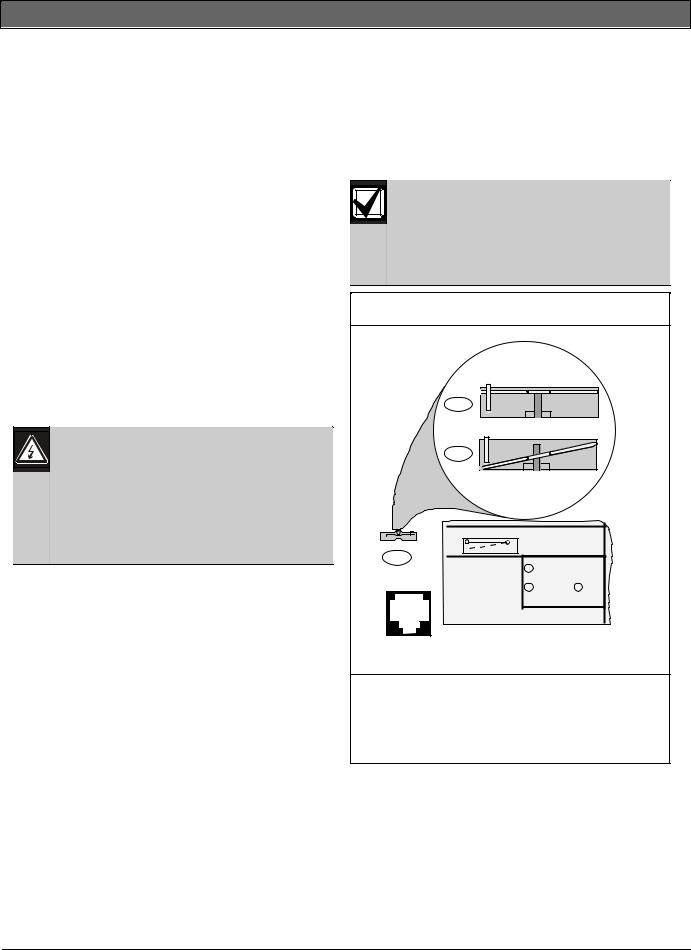
D9412GV2/D7412GV2 | Operation and Installation Guide | 4.0 Installation
4.4Installing the Control Panel
1.Place the control panel over the inside back of the enclosure, aligning the large rectangular openings of the mounting skirt with the mounting hooks of the enclosure. Slide the control panel down so that it hangs on the hooks. Refer to Figure 2, Item 2 on page 15.
2.Remove the tape from the #6 x 1/4-in. screw in the mounting tab on the control panel. The screw passes through the mounting tab and into the skirt mounting hole in the enclosure. Tighten the screw to secure the control panel in the enclosure.
3.Connect earth ground to the control panel before making any other connections. Refer to Section 4.5 Connecting Earth Ground.
4.5Connecting Earth Ground
4.5.1Terminal 10
To help prevent damage from electrostatic charges or other transient electrical surges, connect the system to earth ground at Terminal 10 before making other connections. Recommended earth ground references are a grounding rod or a cold water pipe.
Warning:
Do not use telephone or electrical ground for the earth ground connection. Use
1.8 mm (14 AWG) to 1.5 mm (16 AWG) wire when making the connection.
Do not connect other control panel terminals to earth ground.
4.5.2Ground Fault Detect Enable
•A ground fault is a circuit impedance to earth ground. The control panel has a ground fault detection circuit that, when enabled, detects ground faults on Terminals 1 to 9 and 11 to 32. The control panel also detects and annunciates ground faults on any device connected to it.
•To enable ground fault detection, the Ground Fault Detect Enable jumper (S4) (Figure 3) must be locked (closed) and a non-zero value must be entered in the Area 5 Silent Alarm Relay. When jumper S4 is in the unlocked (open) position, the control panel does not detect ground fault conditions.
•If a ground fault condition occurs, the keypads display SERVC GND FAULT and the control panel transmits a GROUND FAULT TROUBLE, AREA 1
(Modem IIIa2 format only).
When the control panel recognizes that the ground fault condition is corrected, and remains corrected for between 5 to 45 consecutive seconds, a Restoral Report is sent.
The D9412GV2 and D7412GV2 Control Panels log and print a Ground Fault event as a Trouble Point 256 if communicating in Modem IIIa2 format. If communicating in BFSK format, the control panels generate an Alarm Zone 5 event.
Figure 3: Ground Fault Detection
1
2 |
GROUND FAULT DETECT
Enabled S4
Disabled
3
ON when
RED PHONE communicating
LED OFF when idle
|
PHONE LINE SEIZED |
|
TIP |
TELCO CORD |
RING |
|
|
|
MODEL D161
1 - With S4 closed, control panel detects ground faults.
2 - With S4 open, control panel does not detect ground faults.
3 - S4, Ground fault detect enable.
16 |
Bosch Security Systems, Inc. | 5/05 | F01U003641B |
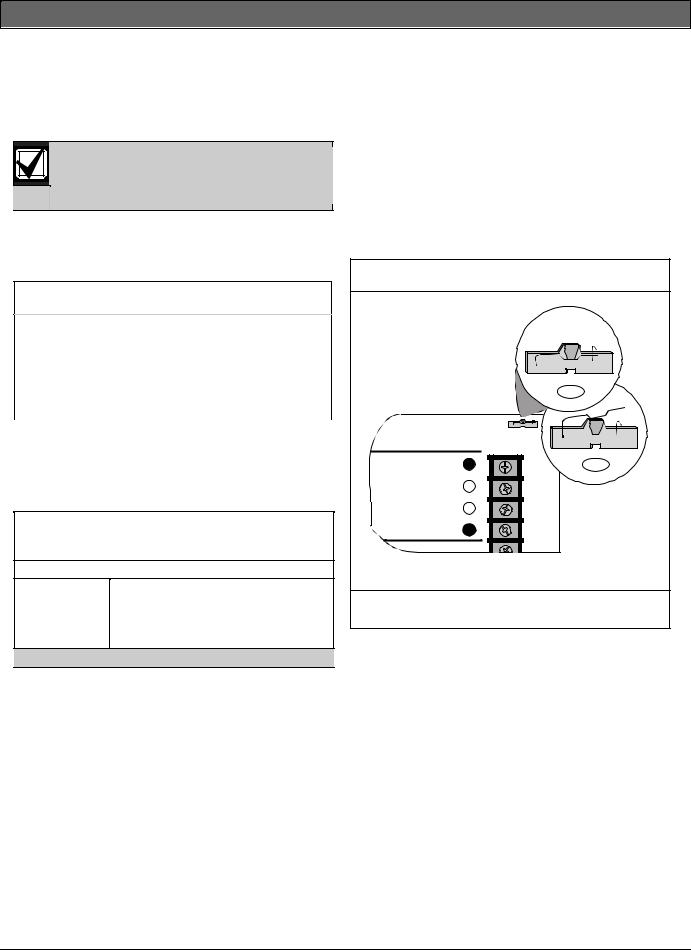
D9412GV2/D7412GV2 | Operation and Installation Guide | 4.0 Installation
4.5.3Enabling Ground Fault Detection
To configure the D9412GV2 and D7412GV2 Control Panels to enable ground fault detection:
1.Set the silent relay in Area 5 to any value from 1 to 128. Do not use a zero (0) value.
The default value for the Area 5 silent relay is 0 (zero). The 0 value disables the ground fault detection function.
2.Close Switch S4 (Figure 3 on page 16). Refer to Table 5 for information about the conditions for enabling and disabling the Ground Fault Detection Circuit.
Table 5: Ground Fault Detection Status
|
|
|
|
Ground Fault |
|
Value of Area 5 |
|
Detection Circuit |
Switch S4 |
Silent Relay Alarm |
|
Enabled |
Closed |
1 to 128 |
|
Disabled |
Closed |
0 |
|
Open |
0 to 128 |
|
|
|
|
4.5.4D9412GV2 and D7412GV2 Ground Fault Specifications
Table 6 provides the impedance specifications for detecting ground faults when any terminal or field wiring is shorted to ground.
Table 6: Ground Fault Impedance
Specifications
|
|
|
|
|
Impedance |
|
Control Panel Detects Ground Fault |
||
|
|
|
|
|
|
≤ 300 Ω |
|
|
Yes |
|
300 Ω to |
|
No |
|
|
200 kΩ |
|
||
|
|
|
||
≥200 kΩ Detection depends upon the terminal
4.5.5Locking the Reset Pin
Locking the reset pin disables the control panel (Figure 4). When the control panel is disabled, the system ignores the keypads and points. CALL FOR SERVICE appears in keypad displays when the pin is locked down.
On-board relays (Terminals 6 and 7) and off-board relays deactivate when the control panel is reset. Terminal 8 has power when the relay is deactivated. Activation interrupts power at that terminal. The onboard relay (Terminal 8) remains deactivated when the reset pin is locked in the disable position.
Releasing the reset pin from the closed position resets the control panel. The control panel resets all its timers, counters, indexes, and buffers. Any points that restore after a reset do not generate Restoral Reports.
If the reset pin is placed in the disable position when all areas are armed, there must be an entry in the Answer Armed program item. Refer to RPS Parameters in the D9412GV2/D7412GV2 Program Entry Guide
(P/N: F01U003636).
Locking the pin in the disable position applies power to the control panel and charges the battery while the detection devices and keypads are installed.
Figure 4: Reset Pin
|
|
|
1 |
|
Reset Pin |
|
|
Disable All Except Battery |
|
||
Charging And Programming |
|
||
PERIPHERAL DEVICE CONNECTIONS |
|
||
RED |
POWER + |
32 |
2 |
YELLOW |
DATA BUS A |
31 |
|
GREEN |
DATA BUS B |
30 |
|
BLACK |
COMMON |
29 |
|
1 - Reset pin locked (closed).
2 - Reset pin normal (open).
Bosch Security Systems, Inc. | 5/05 | F01U003641B |
17 |
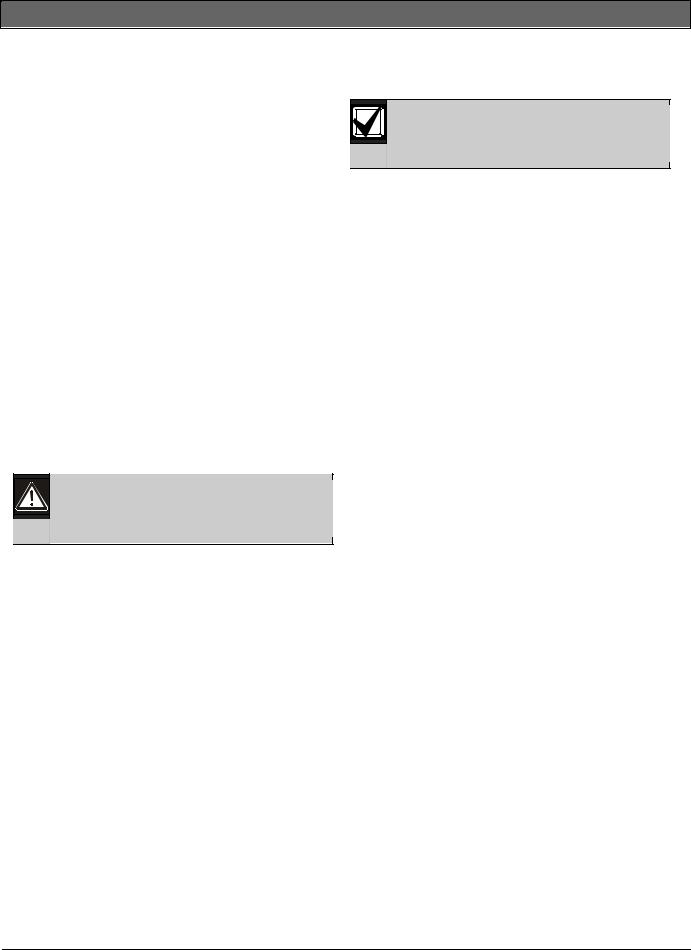
D9412GV2/D7412GV2 | Operation and Installation Guide | 4.0 Installation
4.6Completing the Installation
If not already complete, make the earth ground connection to Terminal 10 and lock the reset pin in the closed position.
4.6.1Charging the Battery
Connect the battery, then the transformer to allow the control panel to charge the battery while you complete the installation. Refer to Section 5.0 Power Supply on page 20 for instructions.
On-board Buzzer Sounds at Power Up and Reset:
The system performs a series of self-diagnostic tests of hardware, software, and programming at power up and at reset. The buzzer on the control panel sounds during the tests. The self-diagnostics tests complete in approximately 1 to 3 seconds.
If the control panel fails any test, the buzzer continues sounding and a System Trouble message appears at the keypads. Refer to Problems Found during Self Diagnostics in the D9412GV2/D7412GV2/D7212GV2 Installation and Troubleshooting Quick Reference Guide (P/N: F01U003638) for a description of each system trouble message.
Touch Terminal 10 First: If the on-board buzzer sounds briefly when the control panel is touched, any static charge you carry discharges to the control panel.
Avoid electrostatic discharge. Always touch Terminal 10, the earth ground connection, before beginning work on the control panel.
If the control panel receives an electrostatic discharge, it might generate Watchdog Reset and Param Fail events. Refer to Watchdog Reset Reports in the D9412GV2/7412G/D7212GV2 Installation and Troubleshooting Quick Reference Guide
P/N: F01U003638) for a description of these events.
4.6.2Installing and Wiring Detection Devices
Install and wire detection devices and keypads at their locations throughout the premises. Do not connect the control panel yet.
Section 8.0 On-Board Points on page 31 contains instructions for wiring the on-board points to detection devices. Section 11.0 Arming Devices on page 53 contains instructions for wiring the keypads.
Instructions for wiring the off-board point POPIT sensor loops are found in the instructions packaged with the POPIT modules.
4.6.3Installing Modules and Relays
1.Power down the unit by unplugging the transformer and disconnecting the battery.
Always power down the unit when installing modules or relays, or when making wiring connections to the control panel.
2.Install and wire any modules required for the installation as described in the module’s installation instructions.
Instructions for the D8125 POPEX Module, D8128D OctoPOPIT Module, D8129 OctoRelay Module, D811 Arm Status Relay Module, and D928 Dual Phone Line Switcher appear in this guide.
Refer to Section 9.0 Off-Board Points on page 34 for D8125 and D8128D instructions. Refer to Section 10.0 Off-Board Relays on page 48 for D8129 and D811 instructions. Refer to Section 7.11 D928 Dual Phone Line Switcher on page 29 for D928 instructions.
3.If using the power outputs at Terminals 7 or 8, install a D136 relay in the appropriate sockets. Refer to Section Programmable Power Output Terminals 6, 7, and 8 on page 25 for instructions.
4.6.4Connecting the On-board Points and Keypads
Connect the on-board points and keypad wiring to the system. Refer to Section 8.0 On-Board Points on page 31 and Section 11.0 Arming Devices on page 53 for instructions.
4.6.5Powering Up
Reconnect the battery, then plug in the transformer. The buzzer sounds for 2 seconds when the control panel is powered up. Leave the reset pin in the locked position.
Yellow Charging Status LED Remains Lit: If the yellow charging status LED remains lit after five minutes of powering up the control panel, either the battery is deeply discharged or too many powered devices were connected to the control panel. Combined continuous current draw for Terminals 3, 8, 24, and 32, and the accessory connector cannot exceed 1.4 A. Refer to Section 6.0 Power Outputs on page 25 for help.
18 |
Bosch Security Systems, Inc. | 5/05 | F01U003641B |
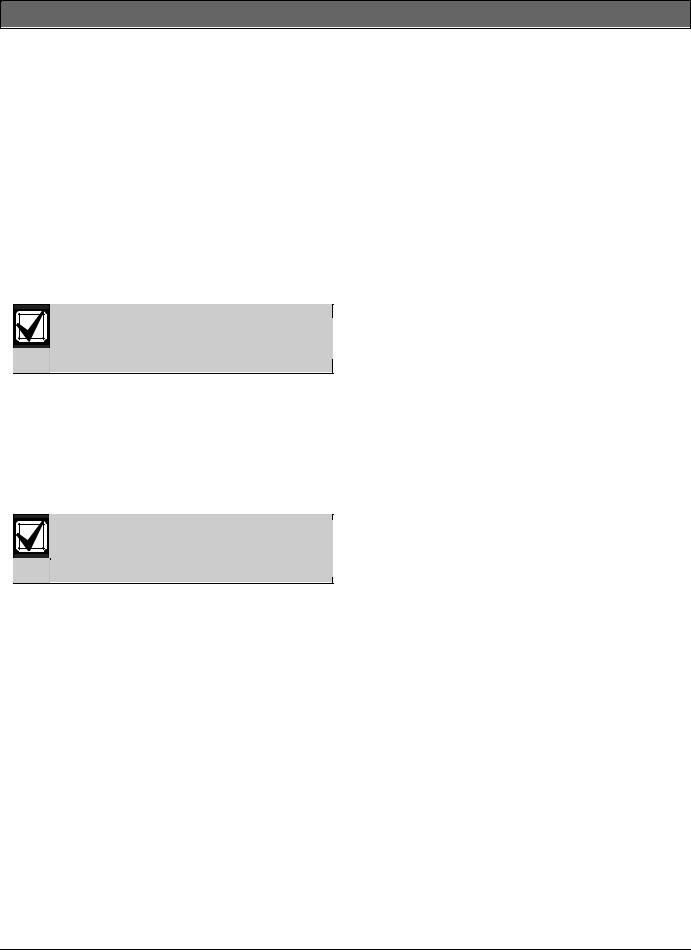
D9412GV2/D7412GV2 | Operation and Installation Guide | 4.0 Installation
4.7Programming the Control Panel
If the control panel is not already programmed, review the D9412GV2/D7412GV2 Program Entry Guide
(P/N: F01U003636). Ensure that all accessory modules for desired features are available for installation. Place the reset pin in the locked position to copy or send information to and from the control panel.
Use the D5200 Programmer or the RPS to load a custom program into the control panel.
Move the reset pin to the normal position refer to (Figure 4 on page 17). The control panel sends Reboot and Battery Reports to the receiver if programmed for reporting
4.8Installing the Point Chart Label
The point chart label is required for fire systems with verifications points.
A point chart label comes in the literature pack. Install the point chart label for fire or combined fire-and- burglary systems that use verification points.
Use the D9412GV2/D7412GV2 Program Record Sheet
(P/N: F01U003635) to gather the necessary information for completing the point chart. Fill out the label and install it on the inside of the enclosure door (refer to Figure 2 on page 15).
Avoid smearing the entries on the chart. Use the peel-off backing to press the label in place.
4.9Testing the System
After installing and programming the control panel, test the system completely. Test the control panel and all devices for proper operation. Test after initially programming the control panel and after subsequent programming sessions.
Refer to the D9412GV2/D7412GV2/D7212GV2 Installation and Troubleshooting Quick Reference Guide
(P/N: F01U003638) for complete Service Walk Test instructions.
Clear after Test: To clear the event memory and report buffer, momentarily close the reset pin. Events stored in the control panel’s event log are not cleared.
Bosch Security Systems, Inc. | 5/05 | F01U003641B |
19 |
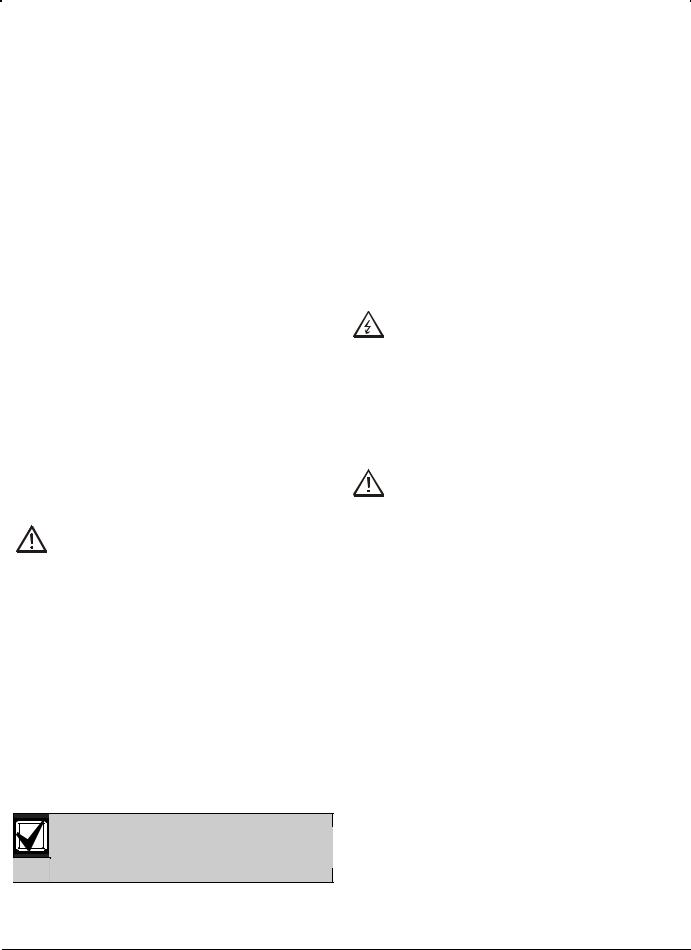
|
D9412GV2/D7412GV2 | Operation and Installation Guide | 5.0 |
Power Supply |
||||
|
|
|
|
|
|
|
5.0 |
Power Supply |
|
5. Secure the transformer to the outlet with the screw |
|||
|
provided. |
|||||
|
D8004 Transformer Enclosure Required for Fire |
|||||
5.1 |
Primary Power Terminals 1 and 2 |
|
||||
|
Systems: Use the D8004 Transformer Enclosure for |
|||||
|
5.1.1 Primary (AC) Power Circuit |
|
the D1640 Transformer in fire and combined fire and |
|||
|
The primary source is a 16.5 VAC, 40 VA, internally- |
|
burglary applications. |
|||
|
|
Check with the Authority Having Jurisdiction (AHJ) |
||||
|
fused transformer (Bosch Security Systems Model |
|
||||
|
D1640). The control panel draws 200 mA when idle |
|
about mounting transformers on specific circuits. |
|||
|
and 500 mA when in an alarm state. The total available |
5.2 |
Secondary Power Terminals |
|||
|
auxiliary current is 1.4 A. |
5.2.1 |
Secondary (DC) Power |
|||
|
Transient suppressors and spark gaps protect the circuit |
|||||
|
|
A 12 V, 7 Ah (up to 14 Ah) sealed lead-acid |
||||
|
from power surges. This protection relies on the |
|
||||
|
|
rechargeable battery (D126) supplies secondary power |
||||
|
ground connection at Terminal 10. Ensure that you |
|
||||
|
|
for auxiliary and alarm outputs, and powers the system |
||||
|
connect Terminal 10 to a proper ground. Refer to |
|
||||
|
|
during interruptions in primary (AC) power. |
||||
|
Section 4.5 Connecting Earth Ground on page 16. |
|
||||
|
|
|
|
|
||
|
AC Power Failure |
|
|
Warning - Use Lead Acid Batteries Only: |
|
|
|
|
|
||||
|
The system indicates an AC power failure when |
|
|
The charging circuit is calibrated for lead- |
|
|
|
|
|
acid batteries. Do not use gel-cell or nicad |
|
||
|
Terminals 1 and 2 do not have power. The AC Fail |
|
|
|
||
|
|
|
batteries. |
|
||
|
Time program item sets the number of minutes or |
|
|
|
||
|
|
|
|
|
||
|
seconds without AC power before the control panel |
|
Extra Batteries Increase Back-up Time: To increase |
|||
|
acknowledges the failure and the number of minutes or |
|
battery back-up time, connect a second 12 V, 7 Ah |
|||
|
seconds after the power returns before the control |
|
battery in parallel to the first battery to form a 12 V, 14 |
|||
|
panel acknowledges restored power. Refer to the |
|
Ah battery. Use a D122 Dual Battery Harness to ensure |
|||
|
D9412GV2/D7412GV2 Program Entry Guide |
|
proper and safe connection. |
|||
|
(P/N: F01U003636) for additional information about |
|
|
Caution: When connecting two D1218 |
|
|
|
|
|
|
|||
|
AC Fail Time. |
|
|
|
||
|
|
|
Batteries to the control panel, both must have |
|
||
5.1.2 |
Installing the Transformer |
|
|
|
||
|
|
the same capacity (use two 17.2 Ah batteries |
|
|||
|
|
|
|
|
|
|
|
|
Do not short the terminals of the |
|
|
or two 18 Ah batteries). |
|
|
|
|
|
|||
|
|
transformer: Shorting the terminals opens |
|
D1218 Battery |
||
|
|
the internal fuse, causing permanent failure. |
|
The D1218 is a 12 V, 17.2 or 18 Ah battery for use in |
||
|
|
|
||||
|
|
Connect the transformer to Terminals 1 and |
|
|||
|
|
|
applications requiring extended battery standby time. |
|||
|
|
2 of the control panel before plugging it into |
|
|||
|
|
|
Up to two D1218 batteries can be connected when |
|||
|
|
the power source. |
|
|||
|
|
|
used with a D122 Dual Battery Harness. |
|||
|
|
|
|
|||
1.Use 1.22 mm (18 AWG) wire (minimum) to connect the transformer to the control panel.
The wire length should be as short as possible. The maximum length is 15 m (50 ft.). Connect the battery and plug in the transformer.
2.Route telephone and sensor loop wiring away from any AC conductors, including the transformer wire.
AC wiring can induce noise and low level voltage into adjacent wiring. Route data wiring away from AC and telephone wiring.
Always connect the battery first and then plug in the transformer.
3.Connect the battery. Refer to Section 5.2.2 Installing the Battery on page 21.
4.Plug the transformer into an unswitched, 120 VAC, 60 Hz power outlet only.
20 |
Bosch Security Systems, Inc. | 5/05 | F01U003641B |
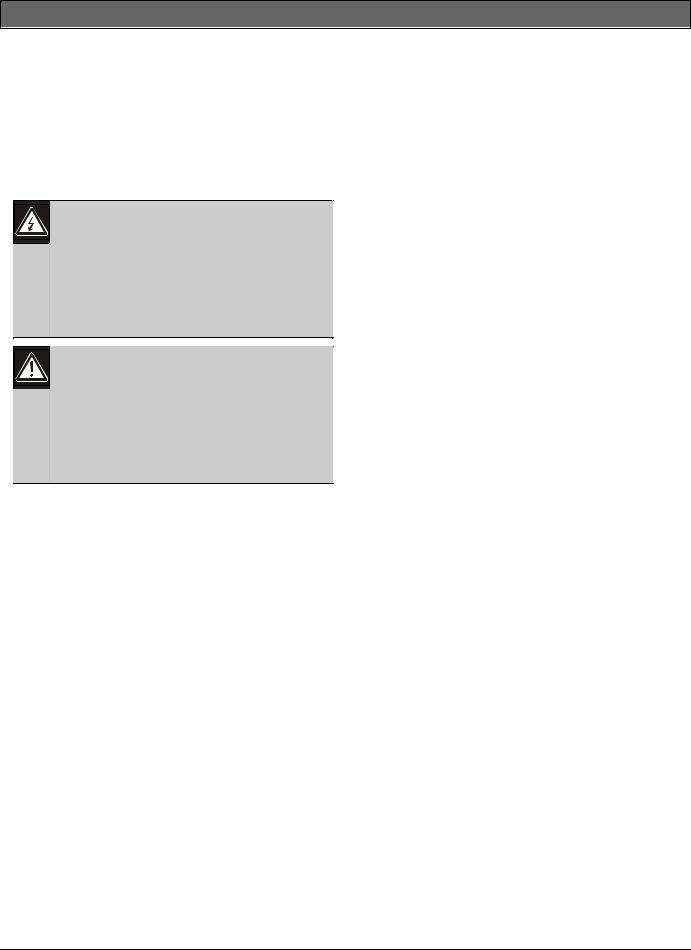
D9412GV2/D7412GV2 | Operation and Installation Guide | 5.0 Power Supply
5.2.2Installing the Battery
1.Place the battery upright in the base of the enclosure.
2.Locate the red and black leads supplied in the literature pack.
3.Connect the black battery lead to Terminal 4, and then to the negative (-) side of the battery.
4.Connect the red battery lead to Terminal 5, and then to the positive (+) side of the battery.
Warning: High current arcs are possible. The positive (red) battery lead and Terminal 5 can create high current arcs if shorted to other terminals or the enclosure. Use caution when working with the positive lead and Terminal 5. Always disconnect the positive (red) lead from the battery before removing it from Terminal 5.
Caution: The battery terminals and wire are not power limited. A 6.4 mm (0.250 in.) space must be maintained between the battery terminals, battery wiring, and all other wiring. Battery wiring cannot share the same conduit, conduit fittings, or conduit knockouts with other wiring. Refer to Figure 5 on page 22.
Bosch Security Systems, Inc. | 5/05 | F01U003641B |
21 |
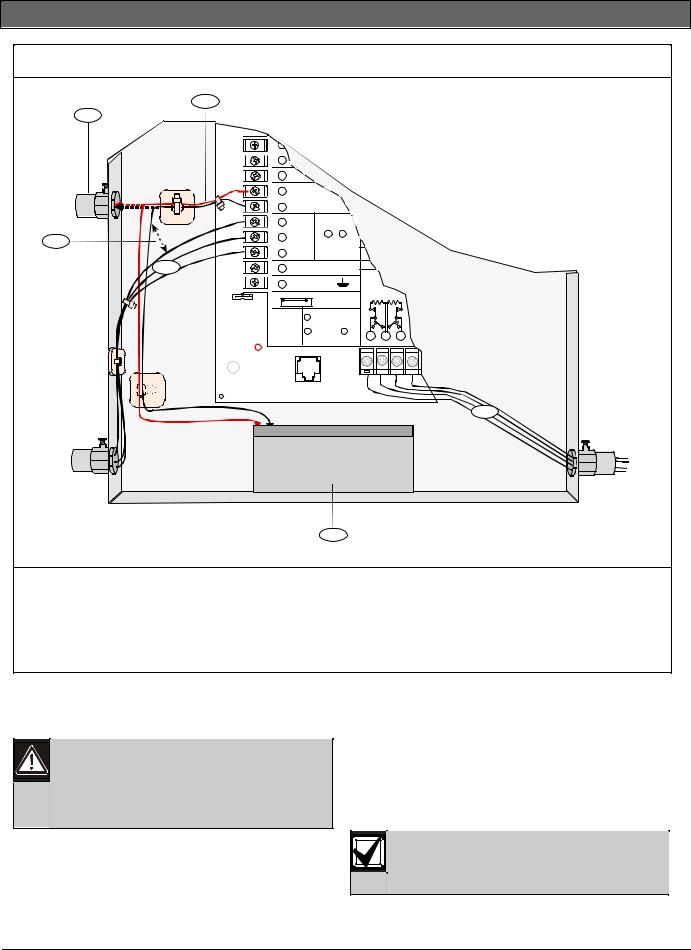
D9412GV2/D7412GV2 | Operation and Installation Guide | 5.0 Power Supply
Figure 5: |
Non-Power-Limited Wiring |
|
|
|
|
|
|
2 |
|
|
|
|
|
|
1 |
|
|
|
|
|
|
|
1 |
|
|
|
|
|
|
2 |
D |
|
|
|
|
|
3 |
|
|
|
|
|
|
4 |
|
|
|
|
|
|
5 |
|
|
|
|
|
|
6 |
|
|
|
|
3 |
|
7 |
|
7 |
8 |
|
|
|
|
|
|
||
|
|
|
|
|
|
|
|
|
8 |
|
|
|
|
|
4 |
9 |
|
|
|
|
|
|
10 |
|
|
|
|
|
|
|
|
|
|
Point 1 Point 2 |
|
|
|
|
PHONE |
ON when |
|
|
|
|
REDRED |
communicating |
|
|
|
|
|
|
LED |
OFF when idle |
|
|
|
|
|
PHONE LINE SEIZEDD |
|
|
|
|
|
TIPTIP |
TELCO |
RINGRING |
11 12 13 |
|
|
|
|
TELCO |
|
|
|
PHONE |
ON when |
RED |
communicating |
|
|
LED |
OFF when idle |
|
PHONE LINE SEIZED |
|
|
|
|
TIP |
RING |
TELCO
5
6
1 - |
Conduit, required only if external batteries are |
4- |
Option wires |
|
used. |
5- Output or zone wires |
|
2 - |
Battery wires |
6- |
Standby battery |
3 - 6.4 mm (0.25 in.) minimum. To ensure proper spacing, use tie-wraps or similar devices to secure wires.
5.2.3Replacing the Battery
Replace batteries every 3 to 5 years under normal use. Record the date of installation directly on the battery.
Caution: Exceeding the maximum output ratings or installing the transformer in an outlet that is routinely switched off causes heavy discharges. Routine heavy discharges can lead to premature battery failure.
D8132 Boost Battery Backup: Adding a D8132 Battery Charger Module supports additional batteries of up to 27 Ah capacity, if required. The D8132 Battery Charger Module can be used to connect two additional batteries for a total of four.
The control panel plus any connected D8132 Modules and auxiliary power supplies must be on the same AC circuit to discharge evenly if AC power fails. The number of D8132 Modules is determined by the number of available outlets on the same circuit. Refer to the Standby Battery and Current Rating Chart in the D9412GV2/D7412GV2 Approved Applications Compliance Guide (P/N: F01U003639) for battery standby time calculations.
In applications where the supervision of two batteries is required by the AHJ, use a D113 Battery Supervision Module.
22 |
Bosch Security Systems, Inc. | 5/05 | F01U003641B |
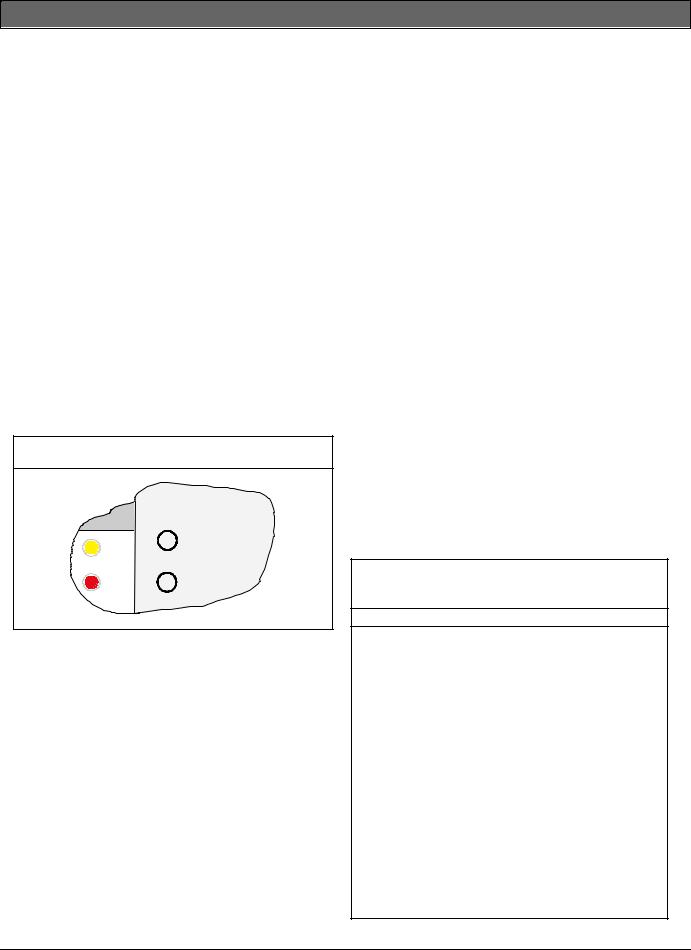
D9412GV2/D7412GV2 | Operation and Installation Guide | 5.0 Power Supply
5.2.4Battery Supervision
When battery voltage drops to 13.8 VDC, the yellow Charging Status LED illuminates. When the battery voltage drops to 12 VDC to 11.8 VDC, the red Low Battery LED lights, and the keypad or keypads display SERVC LOW BATT. The control panel (if programmed for power supervision) sends a BATTERY LOW report in the Modem IIIa2 communication format. It sends a TROUBLE ZN 9 report in the BFSK format.
If the battery is missing or shorted, the red Low Battery LED flashes at the same rate as the green Operation Monitor LED. If the control panel is programmed for power supervision, it sends a BATTERY MISSING report in the Modem IIIa2 communication format, or TROUBLE ZN 9 report in the BFSK format.
When battery voltage returns to 13.7 VDC, the Low Battery LED turns off and the keypad or keypads clear the SERVC LOW BATT message. If the control panel is programmed for power supervision, it sends a BATTERY RESTORAL report in the Modem IIIa2 communication format or a RESTORAL ZN 9 report in the BFSK format. At 13.9 VDC, the yellow Charging Status LED stops lighting.
Figure 6: Charging and Battery LEDs
LEDs Off When Normal
YEL Charging Status
RED Low Battery
Investigate Low Battery reports immediately: If primary (AC) power is off and the discharge continues, the control panel becomes inoperative when the battery voltage drops below 10.2 VDC.
5.2.5 Battery Charging Circuit
Float Charge
The float voltage for the battery charging circuit is 13.9 VDC at a maximum current of 1.4 A, less any devices connected to the control panel. If the float voltage drops below 13.8 VDC due to overload or battery discharge, the yellow Charging Status LED lights.
Loss of AC Load Shed Relay protects battery:
During an AC power loss, the battery supplies all power to the security system. If the battery voltage falls below 10.0 V during an AC power loss, a load shed relay isolates the battery from the control panel and disables the control panel. Load shed protects the battery from being damaged by deep discharge. When AC power restores, the load shed relay reconnects the charging circuit on the control panel to the battery and the battery begins to recharge.
Overcharge Load Shed With AC Present: If more than 1.4 A of auxiliary current draw from the control panel occurs, the battery supplies the current and begins to discharge. If this situation is not corrected, the battery continues to discharge and at 11.8 VDC to
12.0 VDC, the keypads display Serv Low Batt.
When the battery voltage drops below 10.0 VDC, the control panel shuts down. Remove all loads to the control panel and disconnect AC power. Add a new battery and reconnect AC power.
Reset the control panel by momentarily placing the reset pin in the disable position. Refer to Figure 4 on page 17. The red Low Battery LED continues flashing until the control panel resets.
A shorted battery condition is created either by a shorted cell inside the battery or by a short on Terminals 4 and 5. A shorted battery might cause the control panel to operate in an unsafe way. This condition generates WATCHDOG RESET reports.
5.2.6Battery Discharge and Recharge Schedule
Table 7: Battery Discharge and Recharge
Schedule
|
|
|
|
Discharge Cycle |
|
||
|
AC Off: |
AC Fail Report when AC fails, if |
|
|
|
|
control panel is programmed to report |
|
|
|
AC failure at occurrence. |
|
13.9 VDC: |
Charging float level. |
|
|
13.8 VDC: |
Charging status LED on. |
|
|
12.0 VDC: |
Low Battery and AC Fail Reports if |
|
|
|
|
programmed. Low battery LED on. |
|
< 10.0 VDC: |
Battery load shed (processing |
|
|
|
|
functions continue if AC is present). |
|
|
|
|
Recharge Cycle |
|
||
|
AC On: |
|
Load shed relay reset; battery |
|
|
||
|
|
|
charging begins; Battery Trouble and |
|
|
|
AC Restoral Reports sent. |
|
13.7 VDC: |
|
Battery Restoral Reports sent. Low |
|
|
|
battery LED off. |
|
13.9 VDC: |
|
Changing status LED off; battery float |
|
|
|
charged. |
|
|
|
|
Bosch Security Systems, Inc. | 5/05 | F01U003641B |
23 |
